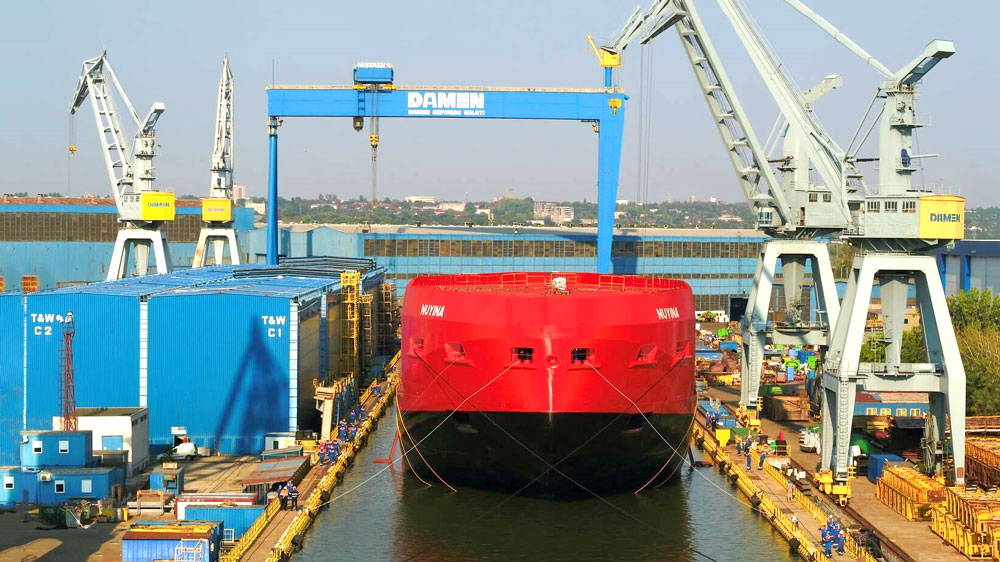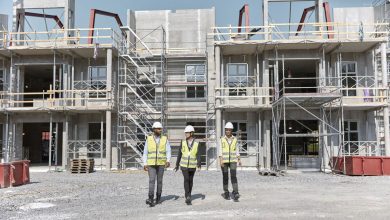Damen performs float-out of Australian icebreaker
Damen has carried out the successful floating of the Antarctic Supply Research Vessel (ASRV) RSV Nuyina currently under construction at Damen Shipyards Galati. The carefully executed procedure was achieved by raising the water level in the yard’s dry dock by six metres; a process taking two days to complete.
Once afloat, the vessel was manoeuvred 250 metres to a quayside berth where the ongoing construction and outfitting process will take place.
Damen is building the 160-metre long ASRV for Serco subsidiary DMS Maritime on behalf of the Australian Department of the Environment and Energy. The vessel has been designed with a multi-mission role in mind. It will keep Australia’s three permanent research stations on the Antarctic continent and its research station on Macquarie Island supplied with cargo, equipment and personnel. Additionally, it will serve as a fully equipped research laboratory facility for up to 116 scientific staff.
Collaborative process
Construction of the vessel began in August 2017. Building from the keel up, the build process has reached the fourth deck level in that time. Now that the vessel is afloat, construction will continue with the positioning of pre-fabricated superstructure blocks, bringing the finished vessel to its full 10-deck height of just over 50 metres.
The construction process is calling on input from two different Damen yards: Damen Schelde Naval Shipbuilding in the Netherlands is providing engineering and project management services, and Damen Shipyards Galati is carrying out vessel construction and outfitting tasks. Talking about the cooperation between the two yards, Damen Project Director Joop Noordijk says: “This project is benefiting from the great collaborative relationship between these two sister companies – one that has been built up during the building of seven previous vessels for the Royal Netherlands Navy.”
Complex contracts
“This is a great achievement for all involved,” concurs Rino Brugge, Managing Director Damen Shipyards Galati. “We still have a long way to go until final delivery, but this float-out once again highlights the extraordinary capability we have for building extremely complex high-end vessels for the broadest range of maritime clients – including commercial operators as well as government and naval contracts.”
RSV Nuyina afloat
Australia’s new Antarctic icebreaker, RSV Nuyina, is now floating, after more than 50 Olympic swimming pools of water were pumped into the docks where the ship is being built.
It took two days to pump enough water from the nearby river into the dry and wet docks, raising the water level six metres and floating the 10,751-tonne ship about 30 centimetres above the dock floor.
Australian Antarctic Division Icebreaker Project Manager Nick Browne, said it was a precision operation to then manoeuvre the ship about 250 metres into the adjacent wet dock.
“We had 34 buoyancy bags tethered in strategic places around the ship to ensure the bow and stern were level for floating out,” Nick Browne explained.
“Then we used a series of controlled lines to pull the ship into position in the wet dock. The ship is 25.6 metres wide and the dry dock is 35 metres wide, so we had less than five metres either side. There’s about 10 metres of water in the wet dock, which will be enough to support the 16,000-tonne weight of the ship when she’s completed,” he pointed out.
Construction on the ship has reached deck four (the science deck), and the engines, generators, shaft lines, propellers and rudders are all in place.
A number of steel blocks that will form the ‘superstructure’ (decks above the hull) have already been constructed and are ready to be lifted onto the ship in the wet dock.
When complete the ship will rise to 10 decks, at navigation bridge level, measuring 50.2 metres from the keel to the top of the weather radar on the main mast.
Australian Antarctic Division Modernisation Program Manager Rob Bryson, said it’s an exciting milestone in the build.
“After six years of planning and more than two years of construction, it’s a real thrill to see it all come together today, with the ship actually floating in the water,” Bryson added. “We’ll see the Nuyina rapidly taking shape over the next few months; it won’t be long now before she’ll be sailing into her home port of Hobart in 2020.”
RSV Nuyina will be the main lifeline to Australia’s Antarctic and sub-Antarctic research stations and the central platform of the Antarctic and Southern Ocean scientific research. Construction commenced in May 2017, with a steel cutting ceremony, while a keel laying ceremony in August saw the first building-block of the ship consolidated in the drydock.
In September 2018 the ship was floated from the dry dock to the wet dock, for the next phase of construction. Construction is expected to be completed at the end of 2019.







